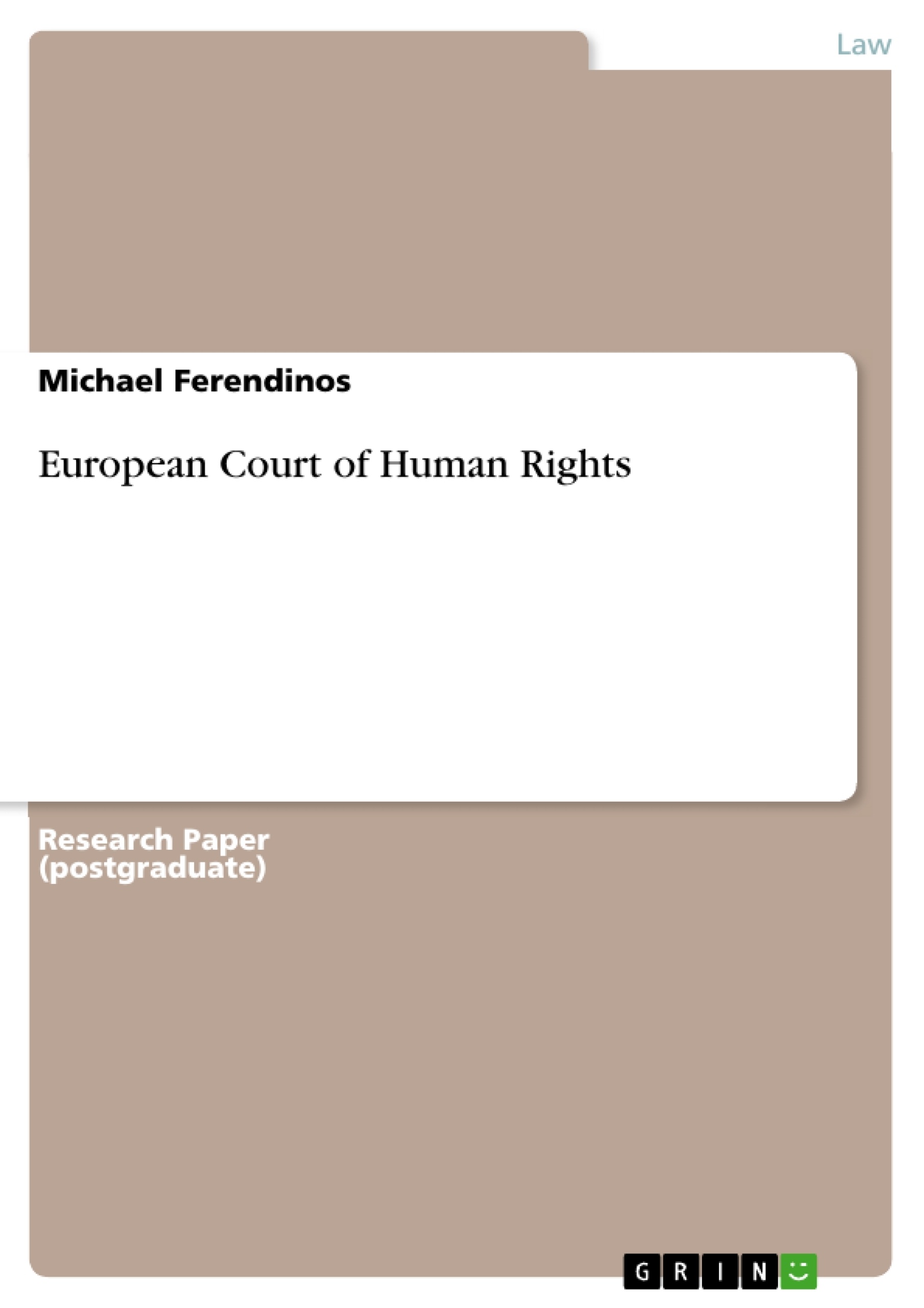This paper will assess the legal impact of the European Court of Human Rights (ECHR) regionally and on the international level. An overview of the Court will be provided initially, followed by an analysis of how it functions. The final section will look at its international influence, whilst using a case study to provide a clear illustration of the authority that the Court wields. The landmark judgment in the Cyprus v. Turkey case in May 2001 will be discussed.
Content Page
Introduction
The Court
Constituting treaty
M andate
Functioning
Composition and structure
Procedure
Effect on international law
Case study: Cyprus v. Turkey
Conclusion
Bibliography
Introduction
This paper will assess the legal impact of the European Court of Human Rights (ECHR) regionally and on the international level. An overview of the Court will be provided initially, followed by an analysis of how it functions. The final section will look at its international influence, whilst using a case study to provide a clear illustration of the authority that the Court wields. The landmark judgment in the Cyprus v. Turkey case in May 2001 will be discussed.
The Court
Constituting treaty
In 1950 - building upon the 1948 Universal Declaration of Human Rights in the aftermath of World War II - the Council of Europe (a pan-European human rights body distinct from the European Union) drew up the Convention for the Protection of Human Rights and Fundamental Freedoms. The Convention was essentially the tool through which the Council of Europe could maintain and build upon the provision of human rights and fundamental freedoms. Furthermore, the Convention represented the initial implementation of the collective enforcement required for some of the rights found within the Universal Declaration (European Court of Human Rights, 2008; BBC, 2008).
Contracting States were bound to the catalogue of civil and political rights and freedoms laid down by the Convention. The Convention created three institutions that were entrusted with the responsibility of enforcing the obligations entered into by these States. They comprised the European Commission of Human Rights; the European Court of Human Rights; and the Committee of Ministers of the Council of Europe, which was made up of the Ministers of Foreign Affairs of the member States or their representatives (European Court of Human Rights, 2008).
M andate
The Court was created in 1959 in Strasbourg. It deals with cases brought by individuals, organisations and Contracting States against other such states, i.e. the nations bound by the Convention; namely, all European nations except Belarus. The ECHR’s mandate is to implement and safeguard the civil and political rights of the continent’s citizens (BBC, 2008).
Before the inception of Protocol No. 9, individuals were not afforded the opportunity to bring their cases before the Court. Thirteen Protocols have been adopted in total since the establishment of the Convention. Six of those, Protocols Nos. 1, 4, 6, 7, 12 and 13, further advanced the rights and liberties of those guaranteed by the Convention. Protocol No. 2 provided the Court with the power to give advisory opinions; the rest of the Protocols dealt with the organisation of and procedure before the Convention institutions (European Court of Human Rights, 2008).
Perhaps the most important Protocol was the implementation of Protocol No. 11 in November 1998, which provided the much-needed restructuring of the enforcement machinery. The number of cases brought before the Convention institutions rose markedly from 1980 onwards, this was exacerbated by the accession of new Contracting States from 1990. To illustrate this increase, the number of annual registered applications climbed from 404 in 1981 to 4,750 in 1997. The purpose of Protocol No. 11 was to handle the case-load by shortening the length of proceedings and by strengthening the judicial character of the system. This aim was met by replacing the part-time Court and Commission with a single, full-time Court. Naturally the Court’s case-load increased drastically as a result, with the number of registered applications shooting up from 5,979 in 1998 to 13,858 in 2001 (European Court of Human Rights, 2008).
Functioning
As mentioned earlier, the now permanent court in its current format came into being in 1998 after the inception of Protocol No. 11. The disbanding of the Committee of Ministers meant that the Court was responsible for screening applications too, making the Convention process wholly judicial. Section II of the Convention (Articles 19-51) sets out the structure and procedure of the Court (European Court of Human Rights, 2008).
[...]
- Quote paper
- M.A. Michael Ferendinos (Author), 2008, European Court of Human Rights, Munich, GRIN Verlag, https://www.grin.com/document/122887
-

-

-

-
Upload your own papers! Earn money and win an iPhone X. -

-
Upload your own papers! Earn money and win an iPhone X. -

-
Upload your own papers! Earn money and win an iPhone X. -

-
Upload your own papers! Earn money and win an iPhone X. -

-
Upload your own papers! Earn money and win an iPhone X.

